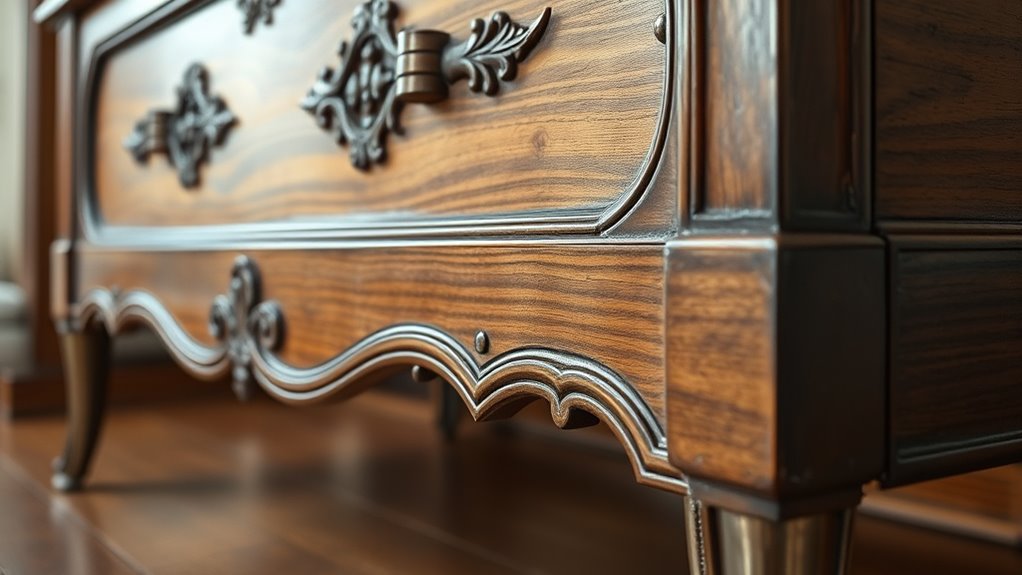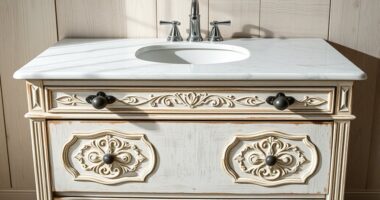Adding new legs to vintage case goods allows you to easily adjust their height and improve stability. Choose the right hardware and attach the legs securely to support both style and function. Taller legs can make the furniture feel more open, while shorter ones create a grounded look. Proper installation guarantees stability over time, and you can customize the height for your space. If you want to discover more tips, keep exploring how to make your vintage piece both stylish and sturdy.
Key Takeaways
- Choose leg height based on furniture function and desired room proportions for optimal comfort and style.
- Ensure hardware supports the weight and prevents wobbling for long-term stability.
- Use precise measurements and align holes accurately when attaching taller or shorter legs.
- Select sturdy materials and secure fastening methods to maintain stability, especially with taller legs.
- Consider the overall aesthetic to balance height and stability, enhancing both look and functionality.

Adding legs to vintage furniture is a simple way to refresh its appearance and enhance stability. When you decide to attach new legs, you’re not just changing the piece’s height—you’re also opening opportunities for aesthetic enhancements that can transform its overall look. The right leg attachment techniques ensure the new legs are secure and durable, giving your furniture both style and functionality. First, you need to choose the appropriate attachment method based on your furniture’s design and your skill level. Common techniques include using corner blocks, mounting plates, or directly screwing into pre-existing holes or drilled inserts. Corner blocks offer a sturdy, traditional approach, where you attach the legs internally for a clean exterior. Mounting plates are more modern, providing a flat surface to secure the legs with screws, often making replacements easier in the future. If your vintage piece already has existing holes or mounting points, drilling precise holes aligned with your new legs simplifies the process and ensures a tight fit. Whichever technique you choose, make sure to use quality hardware that can support the weight of the furniture and its contents.
Additionally, understanding proper hardware selection and its impact on stability can help prevent wobbling or tilting over time. Once you’ve secured the legs, consider how they contribute to aesthetic enhancements. The style, material, and finish of your new legs can dramatically change the character of your vintage piece. For example, sleek metal legs lend a contemporary vibe, while tapered wooden legs evoke mid-century modern charm. You might opt for painted or distressed finishes to match the existing patina or to create a contrasting look that draws attention. The height you select influences not just the furniture’s functionality but also its visual balance within a room. Taller legs can elevate a piece to make it feel more open and less bulky, while shorter ones create a grounded, cozy feel. When choosing the height, think about the room’s proportions and how you plan to use the furniture—whether as a side table, a storage unit, or a statement piece.
Proper leg attachment not only boosts stability but also allows you to customize the furniture’s style and height to suit your space. By carefully selecting the right attachment techniques, you ensure a secure fit, and by choosing aesthetic enhancements that match your decor, you breathe new life into vintage furniture. This simple upgrade can make your piece more functional, stylish, and a true reflection of your personal taste. With a bit of effort and attention to detail, adding new legs becomes a rewarding project that refreshes your vintage furniture and enhances your living space.
Frequently Asked Questions
What Tools Are Needed for Attaching New Legs Securely?
You’ll need a drill with the right drill bit selection, usually a bit suitable for wood or metal, depending on your hardware. Gather the leg mounting hardware, such as bolts or screws, to attach the new legs securely. Make sure to measure and mark the spots accurately before drilling. Use a screwdriver for tightening, ensuring the legs are firmly attached and stable, giving your vintage piece a fresh, sturdy look.
How Do I Choose the Right Leg Height for Stability?
Finding the perfect leg height involves balancing the subtle art of proportion and stability. Consider your furniture’s intended use and existing design elements to guide your choice. Typically, taller legs elevate the piece’s presence, but too high can compromise stability. Pay attention to stability factors like weight distribution and ground contact. Aim for a height that enhances aesthetics without sacrificing sturdiness, ensuring your vintage piece remains both elegant and reliable.
Can I Retrofit Vintage Furniture With Adjustable Legs?
Yes, you can retrofit vintage furniture with adjustable legs using retrofit techniques. First, assess the vintage leg materials to guarantee compatibility; wood, metal, or plastic may require different approaches. Remove the old legs carefully, then attach adjustable legs designed for your furniture type. Secure them firmly, ensuring stability and proper height. This upgrade enhances your piece’s functionality while preserving its vintage charm.
What Materials Are Best for Restoring Vintage Leg Attachments?
Think of restoring vintage leg attachments like rebuilding a bridge. You’ll want durable materials like wood glue for sturdy joints and metal brackets for extra support. I once fixed an antique dresser with these, and it held perfectly. Use strong, quality wood for the legs, and secure them with metal brackets for stability. Combining these materials guarantees your vintage piece stays both beautiful and reliable for years to come.
How Do I Ensure the New Legs Match the Furniture’s Style?
To guarantee the new legs match your furniture’s style, focus on its design style and material matching. Identify whether your piece has a vintage, mid-century, or modern look, then choose legs that complement that aesthetic. Opt for materials like wood or metal similar to the original, and select finishes that harmonize with the existing surface. This approach preserves the piece’s character while adding stability and height seamlessly.
Conclusion
By adding legs to vintage valuables, you boost both beauty and balance. This simple step transforms tired tables into trendy treasures, giving your furniture fresh flair and firm footing. With a little creativity and care, you create a sturdy, stylish statement piece that stands tall and stands out. So, seize the chance to secure stability and style—sassy, sturdy, and sensational—by giving your vintage valuables a new lease on life with lovely legs.









